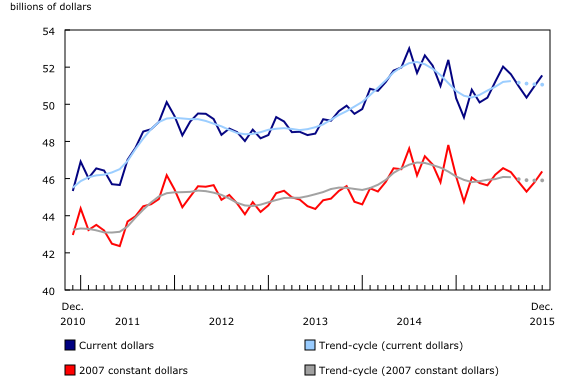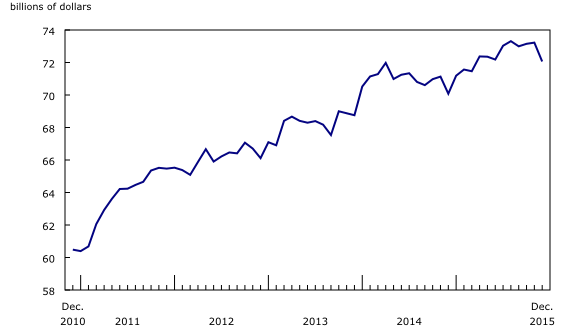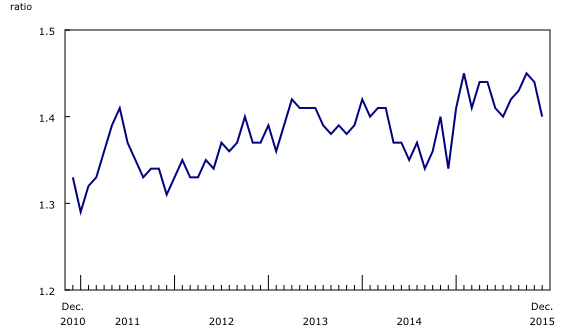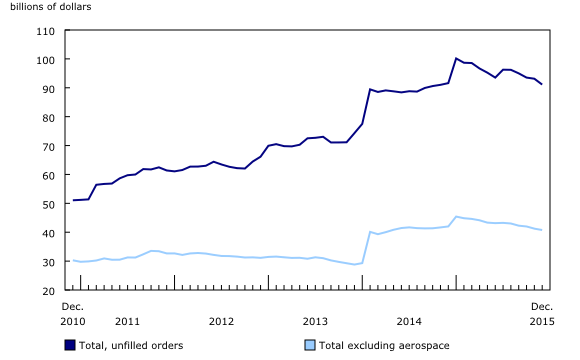Monthly Survey of Manufacturing, December 2015
Archived Content
Information identified as archived is provided for reference, research or recordkeeping purposes. It is not subject to the Government of Canada Web Standards and has not been altered or updated since it was archived. Please "contact us" to request a format other than those available.
Released: 2016-02-16
Manufacturing sales increased 1.2% to $51.6 billion in December, their second consecutive advance.
In December, sales increased in the motor vehicle and wood products industries, representing over half of the national gain. Chemical products, miscellaneous products, ship and boat building, as well as other transportation equipment also posted higher sales, which accounted for almost one-third of the overall increase. Lower sales of petroleum and coal products partly offset the gains.
In constant dollar terms, sales rose 1.3%, indicating that a higher volume of manufactured goods was sold.
In 2015, sales declined 1.5%, the first annual decrease since 2009.
Motor vehicles and wood products post largest gains
Motor vehicle sales increased 3.6% in December, the third consecutive increase for the industry. In the fourth quarter of 2015, some motor vehicle manufacturers released redesigned models of popular vehicles. In addition, employees worked overtime to meet higher customer demand in late 2015, leading to an increase in sales.
Sales of wood products rose 5.5% in December. Wood product manufacturers typically shut down for part of December. Despite the shutdowns, sales were at their highest level since December 2006. Exports of lumber and other sawmill and millwork products, as well as logs, pulpwood and other forestry products increased in December. In recent years, the wood products industry has experienced a turnaround, as annual sales increased from 2011 to 2015, reflecting growing foreign demand.
A 2.4% decline in sales of petroleum and coal products partially offset the gains. Prices fell 5.3% for the industry, according to the Industrial Product Price Index.
Sales increase in seven provinces
Seven provinces posted higher sales in December. Quebec, New Brunswick and Ontario reported the largest gains, which were partly offset by lower sales in Alberta.
Sales increased 1.7% in Quebec, reflecting gains in 11 of 21 industries. In the wood products industry, sales rose 8.2%, as manufacturers reported higher than normal sales in December. Sales of primary metals (+3.2%) and chemicals (+5.6%) were up. In contrast to Canada as a whole, sales of petroleum and coal products increased in Quebec, contributing to the provincial gain.
Higher sales of non-durable products led to a 16.8% increase in New Brunswick. At the same time, exports of refined petroleum products rose in December.
Sales rose 0.7% in Ontario, a third consecutive increase. The motor vehicle industry was mainly responsible for the gain, as sales advanced 3.6%, reflecting increased demand for redesigned vehicles. Higher sales of machinery bolstered the gain in December, with sales rising 6.5% in the industry. The bulk of the increase stemmed from industrial machinery sales. A number of respondents in this sub-industry completed large contracts in December, which led to higher sales. Sales were down 7.7% in petroleum and coal products and down 6.2% in primary metals, offsetting some of the provincial gains.
Sales decreased 2.4% in Alberta, the sixth consecutive decline for the province. Lower sales of petroleum and coal products were responsible for the drop in December.
Inventories decrease
Inventories declined 1.6% in December, reflecting decreases in aerospace products and parts, as well as petroleum and coal. In the aerospace industry, manufacturers reported a 5.0% drop in inventories. Inventories fell 7.8% in the petroleum and coal industry, reflecting lower raw materials on hand. According to the Raw Materials Price Index, prices for crude energy products fell 11.9% in December.
The inventory-to-sales ratio fell from 1.44 in November to 1.40 in December. The inventory-to-sales ratio measures the time, in months, that would be required to exhaust inventories if sales were to remain at their current level.
Unfilled orders decline for fifth consecutive month
Unfilled orders declined 2.2% in December, the fifth consecutive decrease. Orders had reached a $100.2 billion peak in January 2015, reflecting growth in aerospace products and parts; since then, they have generally been declining, as the industry delivered on contracts. Unfilled orders represent potential sales for manufacturers, unless cancelled or re-valued. In December, aerospace orders fell 3.0%. Machinery manufacturers reported a 4.1% decline in unfilled orders, as they delivered on contracts at the end of the year.
New orders fell 2.1%, mainly reflecting a decline in orders for the aerospace industry.
Year 2015 in review: Sales decrease for the first time since 2009
The following analysis is based on current estimates for 2015. Manufacturing sales declined 1.5% in 2015 to $609.5 billion, the sector's first annual decrease since 2009. After contracting in 2008 and 2009 during the recession, sales in the manufacturing sector rebounded in subsequent years and rose until 2015. In constant dollars, sales fell 0.9% in 2015.
The petroleum and coal products industry was mainly responsible for the downturn in 2015. Sales in the industry fell 28.6%, reflecting a 22.3% drop in the average price of refined petroleum products. Excluding petroleum and coal products, manufacturing sales increased 2.6% in 2015.
Sales increased on an annual basis in 12 out of 21 industries. Transportation equipment posted the largest gain, with motor vehicles accounting for roughly half of the dollar increase. Sales of motor vehicles rose 9.1%, reflecting price increases. The depreciation of the Canadian dollar relative to the US dollar contributed to higher motor vehicle sales in 2015, as vehicles are sometimes priced in US dollars. Many motor vehicle manufacturers also shifted production to high-end vehicles, a number of which were redesigned in 2015. Despite the increase in dollars, the number of vehicles produced declined in 2015. Industries related to motor vehicles production also recorded growth in 2015. Sales were up 8.9% for motor vehicle parts and up 5.4% for plastics and rubber products.
Provinces heavily involved in the oil and gas extraction sector accounted for the bulk of the manufacturing decline in 2015. In Alberta, a 35.6% decrease in sales of petroleum and coal products led to an overall drop of 13.7% in the province. Sales of machinery products fell 26.7%, reflecting lower sales of oil and gas field machinery, a sub-industry that supplies companies in the oil and gas extraction sector.
In New Brunswick, sales fell 9.8%, reflecting declines in the non-durable goods industries. In Saskatchewan, sales decreased 11.4%.
Sales fell 0.6% in Quebec, as lower sales of petroleum and coal products were largely offset by gains in 15 of 21 industries. Production increased 10.2% in aerospace products and parts. Gains in the paper, food and wood products industries also helped to moderate the decline in petroleum.
The opposing influences attributable to strength in transportation and weakness in petroleum were evident in Ontario. Sales increased 1.8% in the province, despite a 28.2% decline in petroleum and coal products. Excluding petroleum and coal products, sales rose 4.2% in the province. Motor vehicle sales advanced 8.5%, as prices rose and the industry shifted to higher-end models. Gains in the motor vehicle parts and machinery also contributed to the increase.
Note to readers
Monthly data in this release are seasonally adjusted and are expressed in current dollars unless otherwise specified. For information on seasonal adjustment, please refer to the following document: Seasonally adjusted data – Frequently asked questions.
For information on trend-cycle data, see Trend-cycle estimates – Frequently asked questions.
Non-durable goods industries include food, beverage and tobacco products, textile mills, textile product mills, clothing, leather and allied products, paper, printing and related support activities, petroleum and coal products, chemicals, and plastics and rubber products.
Durable goods industries include wood products, non-metallic mineral products, primary metal, fabricated metal products, machinery, computer and electronic products, electrical equipment, appliances and components, transportation equipment, furniture and related products and miscellaneous manufacturing.
Production-based industries
For the aerospace industry and shipbuilding industries, the value of production is used instead of sales of goods manufactured. This value is calculated by adjusting monthly sales of goods manufactured by the monthly change in inventories of goods in process and finished products manufactured. Production is used because of the extended period of time that it normally takes to manufacture products in those industries.
Unfilled orders are a stock of orders that will contribute to future sales assuming that the orders are not cancelled.
New orders are those received whether sold in the current month or not. New orders are measured as the sum of sales for the current month plus the change in unfilled orders from the previous month to the current month.
Manufacturers reporting in US dollars
Some Canadian manufacturers report sales, inventories and unfilled orders in US dollars. These data are then converted to Canadian dollars as part of the data production cycle.
For sales, based on the assumption that they occur throughout the month, the average monthly exchange rate for the reference month (noon spot rate) established by the Bank of Canada is used for the conversion. The monthly average exchange rate is available in CANSIM table 176-0064.
Inventories and unfilled orders are reported at the end of the reference period. For most respondents, the noon spot exchange rate on the last working day of the month is used for the conversion of these variables. However, some manufacturers choose to report their data as of a day other than the last day of the month. In these instances, the noon spot exchange rate on the day selected by the respondent is used. Note that because of exchange rate fluctuations, the noon spot exchange rate on the day selected by the respondent can differ from both the exchange rate on the last working day of the month and the monthly average exchange rate. Noon spot exchange rate data are available in CANSIM table 176-0067.
Revision policy
Each month, the Monthly Survey of Manufacturing releases preliminary estimates for the reference month and revised estimates for the three previous months. Revisions are made to reflect new information provided by respondents, and updates to administrative data. Once a year, a revision project is undertaken to revise multiple years of data. During annual revisions, changes are made to the seasonal adjustment parameters.
Real-time CANSIM tables
Real-time CANSIM tables 304-8014, 304-8015 and 377-8009 will be updated on March 1. For more information, consult the document Real-time CANSIM tables.
Next release
Data from the January Monthly Survey of Manufacturing will be released on March 16.
Contact information
For more information, contact us (toll-free 1-800-263-1136; 514-283-8300; STATCAN.infostats-infostats.STATCAN@canada.ca).
For more information about the concepts, methods or data quality of this release, contact Elizabeth Richards (613-863-4623; elizabeth.richards@canada.ca) or Michael Schimpf (613-863-4480; michael.schimpf@canada.ca), Manufacturing and Wholesale Trade Division.
- Date modified:







